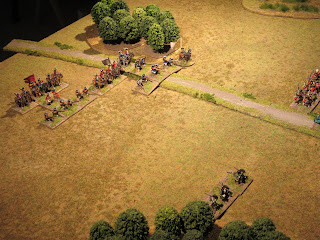Both armies are on the move and in an attempt to hinder their opponent the attacking army have despatch an advance guard to seize and hold a key junction. This must be held until nightfall as reinforcements will arrive the following morning. The opposition have caught wind of the plan and have despatched their own force to contest the move.
Forces and
time clock:
Both forces
are of equal strength, consisting of two battalions of infantry, a unit of
light troops and two regiments of cavalry. Hanover have a ‘bold’ general
commanding their force and the French, a ‘rash’ general. Forces sight one another
at 09.00 hours leaving 13 hours of daylight.
Test one
Using the
Collision Course variant, both forces have marched cross country delaying the
formation of a battle line. The Franch have deployed their cavalry to the left
of their battle line while Hanover have positioned their cavalry to each flank.
Before infantry lines reach shooting distance, a cavalry fight erupts on the Hanoverian right. The resulting combat proves ineffective and both sides break off to rally. Following an exchange of musket volleys, the 1st battalion of Swedes sweep the Hanoverian jaegers away and come face-to-face with Hanoverian line infantry.
Despite being disordered, the 1st battalion of Swedes charge the Hanoverian line forcing them back. Elsewhere, French light troops skirmish with a second Hanoverian battalion. French cavalry, in reserve, wheel right to take the Hanoverians in flank, needing little time to send them off the field. The Hanoverian centre critically exposed, leave the field as nightfall approaches, leaving the French to hold the crossroads.
Test two
Terrain is
changed slightly to give both sides the advantage of road movement. Rain has
fallen making both fields a quagmire limiting the available dry ground.
The brigade of Swedes surge passes the crossroads and are met by the Hanoverian infantry. The Swedish left is charged in flank by Hanoverian cavalry, but these take a withering fire from French light troops positioned at the edge of the wood.
The attack to their flank proves devastating and the Swedes are routed leaving a lone second Swedish battalion to grimly hold on. It does not take long before French command decides to withdraw and leave the crossroads to Hanover.
Observations
Both sides were
able to score a success which is good news. The current series of tests take
place in Western Germany where terrain may vary between arable, hilly or forest
regions. This is determined first by a die cast, followed by the random selection
of a terrain card from the appropriate deck. This negates the use of maps and
time taken for map movement.


















